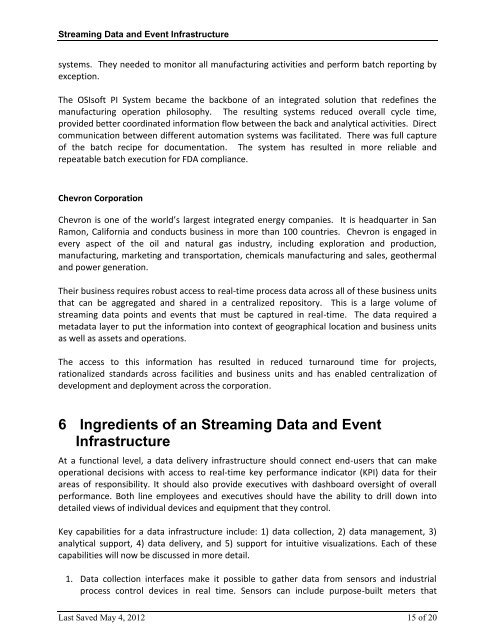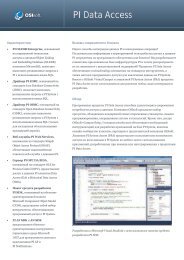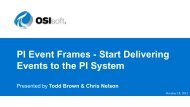Streaming Data and Event Infrastructure - OSIsoft
Streaming Data and Event Infrastructure - OSIsoft
Streaming Data and Event Infrastructure - OSIsoft
You also want an ePaper? Increase the reach of your titles
YUMPU automatically turns print PDFs into web optimized ePapers that Google loves.
<strong>Streaming</strong> <strong>Data</strong> <strong>and</strong> <strong>Event</strong> <strong>Infrastructure</strong><br />
systems. They needed to monitor all manufacturing activities <strong>and</strong> perform batch reporting by<br />
exception.<br />
The <strong>OSIsoft</strong> PI System became the backbone of an integrated solution that redefines the<br />
manufacturing operation philosophy. The resulting systems reduced overall cycle time,<br />
provided better coordinated information flow between the back <strong>and</strong> analytical activities. Direct<br />
communication between different automation systems was facilitated. There was full capture<br />
of the batch recipe for documentation. The system has resulted in more reliable <strong>and</strong><br />
repeatable batch execution for FDA compliance.<br />
Chevron Corporation<br />
Chevron is one of the world’s largest integrated energy companies. It is headquarter in San<br />
Ramon, California <strong>and</strong> conducts business in more than 100 countries. Chevron is engaged in<br />
every aspect of the oil <strong>and</strong> natural gas industry, including exploration <strong>and</strong> production,<br />
manufacturing, marketing <strong>and</strong> transportation, chemicals manufacturing <strong>and</strong> sales, geothermal<br />
<strong>and</strong> power generation.<br />
Their business requires robust access to real-time process data across all of these business units<br />
that can be aggregated <strong>and</strong> shared in a centralized repository. This is a large volume of<br />
streaming data points <strong>and</strong> events that must be captured in real-time. The data required a<br />
metadata layer to put the information into context of geographical location <strong>and</strong> business units<br />
as well as assets <strong>and</strong> operations.<br />
The access to this information has resulted in reduced turnaround time for projects,<br />
rationalized st<strong>and</strong>ards across facilities <strong>and</strong> business units <strong>and</strong> has enabled centralization of<br />
development <strong>and</strong> deployment across the corporation.<br />
6 Ingredients of an <strong>Streaming</strong> <strong>Data</strong> <strong>and</strong> <strong>Event</strong><br />
<strong>Infrastructure</strong><br />
At a functional level, a data delivery infrastructure should connect end-users that can make<br />
operational decisions with access to real-time key performance indicator (KPI) data for their<br />
areas of responsibility. It should also provide executives with dashboard oversight of overall<br />
performance. Both line employees <strong>and</strong> executives should have the ability to drill down into<br />
detailed views of individual devices <strong>and</strong> equipment that they control.<br />
Key capabilities for a data infrastructure include: 1) data collection, 2) data management, 3)<br />
analytical support, 4) data delivery, <strong>and</strong> 5) support for intuitive visualizations. Each of these<br />
capabilities will now be discussed in more detail.<br />
1. <strong>Data</strong> collection interfaces make it possible to gather data from sensors <strong>and</strong> industrial<br />
process control devices in real time. Sensors can include purpose-built meters that<br />
Last Saved May 4, 2012 15 of 20
















